Philosophical
Drawings
The Vision of the Veil
( Unraveling Sufism and other Transcendental
Chimeras)
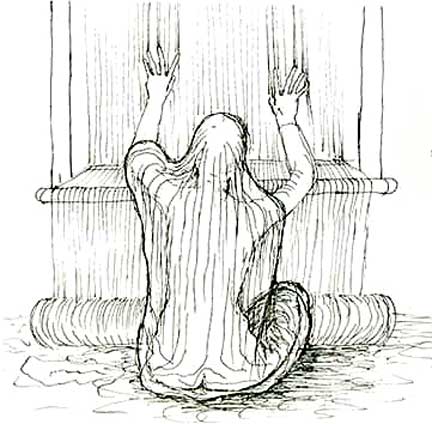
The Veil-maker Weaving
The drawing above is a drawing of a
beautiful weaver of oriental carpets or fine tapestry. She wears a transparent
robe. Years ago, if not now, this was an image of longing for me, of the divine
'beloved' or lover who I might someday weave
my life with. That is the obvious meaning of the image. The truth is more
complex. This drawing was one that was part of a realization that Sufism was not
the truth, and the Veil of Maya, as the Hindu's called it, was a fabrication. I
realized that there was no "Veil" in 1991, the same year I gave up Sufism, Islam, Platonism, Christianity and other interests in religion. I was
well aware of the intellectual and emotion dilation of Sufi mystical states. I
entered into and out of such states myself. But it was a dream I had to
wake up
from. It
took me perhaps ten years to get involved with and then give up the idea of
the veil. One can find the idea of the veil in Plato, Christianity, Hinduism, Sufism, Buddhism,
the poetics of Rumi, Niffari and Ibn Arabi, Hafez and many other systems and
symbolisms, including poets such as Tagore, Blake, Yeats and Rilke. One can find
veil imagery mixed up in Joseph Campbell's ideas as when he says that a person
must be "transparent to the transcendent." Campbell was friends with with
Ed Ricketts and John Steinbeck's who had an idea of "Breaking Through"
experiences. I was probably influenced b this idea when I read Steinbeck's
Cannery Row in 1973. I love Steinbeck books and some of Ricketts' work on Tide
pools and ecology. But Rickett's notion of spiritual poetry now seems misguided
to me, having practiced something like what he imagined myself for a decade or
more. This notion of spiritual transparency is imaginary and I will try to
explain why in this essay.
I came to realize that
veil imagery, both as an orientalist project and as an assay into comparative
religion and gnostic romanticism, was a way of denigrating the actual world and
upholding an elitist and often misogynistic agenda. The idea of the veil is an
imaginary construction--- a metaphor for
transcendent systems of knowledge. The veil is an an attempt to recreate nature
as a transparency over an ideology. The idea of transcendence is about denying the
world in favor of a human created imaginary realms composed of
various abstract ideas or ideological constructs. I had no idea that that is what veil symbolism is
about when I began to use it. How could I have known? But once I saw what it
really was about I abandoned it just as history abandoned the
Greek gods, or as eventually Christianity and Islam will be relics of bygone
superstitious peoples.
So then, this chapter is the story
of the growth and demise of one of my most favorite poetic creations or
metaphors--- the idea of the Veil. It was a beautiful failure and thus not entirely a failure perhaps.
Let's say that a once cherished aesthetic and philosophical theory,
that I thought was something of a creative pinnacle, utterly collapsed. My
masterpiece turned out to be a defeat: the thing to which I had given my breath
and blood was nothing and is now something that has no real value to me except as an example to others of a way not to
go. Is that how it is?
No, it is is not just an example of what should be avoided. It is the story of failure that was beautiful, a
beautiful illusion I created, a chimera, that still manages to radiate some
sort of inverse beauty, even if it is is an example of a way not to go. I was
not to penetrate the veil and discover the total and absolute truth, indeed,
perhaps I am one of those "people of blame" , but ironically so,
since the people of blame were Sufi's who tried to look bad to those who ere
religious. But I am not not merely a "contrary", I am a Sufi who utterly
renounced Sufism----a Sufi who does not believe there
is a god behind the veil and thus no union with a divine beloved. I am become
that hated thing, an "atheist". Perhaps it could be that in the early 21st
century the best things arise out of failure. It might just be possible
for a failure of this magnitude to be luminous anyway. Indeed, the "Vision of the
Veil" was so important to me that to a large degree it structured my thinking and
my world view throughout much of the late 1970's and all through the 1980's. I
put my whole youthful thought, heart and body into it, perhaps 10 or 15 years. It would take some tragic
experiences and no small amount of suffering to wake me from my fierce
attachment to the mythology of the veil. Suffering is a great teacher. Undoing
this mistake has taken me even longer, since I began to unravel and tear down
the veil in 1991. There is no veil, there is nothing behind it to make it a
veil. There is only this world.
I'm writing this chapter mostly out a sense of
honesty and a need to be truthful about the past. I am also a little nostalgic
for an idea I now know is a false idea. I want to write a little chapter on the
history of a pet truth that turned out to be an illusion. Of course one has to
ask the question: what is the difference between a work of art or poem, and a
spiritual fiction or falsehood? When does art cease to be "true" and start being
harmful to other minds?. In art, even the story of murderousness or utter
despair can be
beautiful. There are truths expressed as fiction, and there are fictions that
express falsehoods. There are novels or poems that express terrible ideas or
that support oppressive or imperial regimes but are beautiful. I can
admire the beautiful craft of Henry the Eighth's clothes in the painting by Han Holbein,
at the same time as I can still be aware Henry was a tyrant and murderer who killed some of his wives.
In an similar way, there are scientific
theories that might be true, but nevertheless are not considered part of
mainstream science, or do not serve the dominating status quo of "Big Science"
and so are neglected or overlooked.
My theory of the veil was on the border line between a work of fiction that
expresses a poetic surmise that contains some truth and some falsehoods, and a
spiritual idea that is scientifically absurd. There was real beauty in the idea,
and initially, considerable basis in fact. But this was lost as the idea became
inflated with time and contact with the distorted and falsifying lens of religion.
I originally
believed my theory of the veil was a good aesthetic theory that would help
liberate our society from illusions. The idea was probably nurtured by a sense
that the adult world that was offered to me by my parents, seemed to me to be a
world not worth living in. Had I spent my adolescence less ready to die by
suicide or find of way to escape from the pathetic men of "success" and wealth this society offers as
models, no doubt, I would not have wished to live on the other side of the
veil.
The veil was an exotic orientalist place that I hid my secrets behind, the sanctuary of my dreams, the place
behind which I could be free and unmolested, rising to Sufi heights, embracing
the luminous sunyata void. This desire for transcendent insight was in fact the 'royal'
road to escape form reality. The seeking for this was an effort to escape the
actual world I lived in.
In a certain sense, the drawings of
the Philosophical Drawings are all veils. The world in the
drawings is not the world I actually lived in, but the world
where what I felt and thought mattered. The veil was was a chimerical world hovering
between the actual world and my imagination. In the actual world of Big Business, nearly everyone's
feelings and thoughts do not matter, the 'subject" does not matter--- and people are merely food for a machines of profit
and oppression. I hoped to hold out a alternative reality that was more real that
the false reality of capitalism. It is this perhaps that gives the
Philosophical Drawings a certain human depth and intellectual vivacity, they
resonate with forgotten humanity.
|
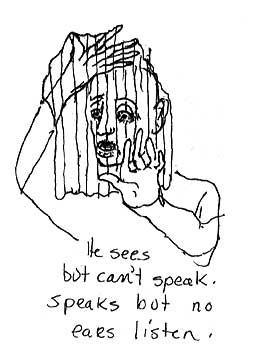
|
But I must hasten to add, that in the end, the veil was itself not a liberating
curtain, but a kind of jail that my alienation put me in, a cocoon of carefully
woven fibers of dreams and illusions that I wove myself into, like a chrysalis
of death. Escaping from it, or rather unraveling, unweaving or dissolving it,
was the work of nearly two decades. It is gone now, like a ghost of the unreal
that slipped in between myself and my real life. I managed eventually to escape
from the need to escape behind the veil.
I nourished the
theory of the veil for many years and loved it. For a time it was my very own
"philosophers stone", which I treated like an untouchable holy grail, a precious
secret, whose closet of mysteries, full of jewels and inner light, should not be opened to the uninitiated. Of course I
know now that is was this preciousness, and exclusivity, the quality of the
arcane and esoteric, that was the reason for the falseness of the theory.
"Art is a veil of spirit" I wrote in 1984. It was a lovely fantasy that helped me explain aspects of the world, and offered
me comfort and beauty and a sense life is not all suffering and there is hope
beyond. But I could not explain what "spirit" was. It was a feeling of life, a
feeling of what mattered, a feeling undefined. I now know that the feeling was
just the feeling of existing, being. I extrapolated from this feeling and
joined myself to religious ideas. In short, the veil idea was my religion, and it took me years to realize
what a tissue of illusions and beneficent lies I had woven around myself, a
false cocoon of enslaving dreams. Having
fallen victim to a religion of my own making taught me a great deal about large
scale religions and how and why they are created and how they deceive and dupe
their followers. The beautiful lies offer comfort to the initiated and make them
feel calm, cared about and superior to others. The escape is a lie, merely a
land of Oz that in the end justifies the very
oppression it is designed to escape from.
The Philosophical Drawings slowly
evolved between 1979 and 1986. In that time I developed a rather elaborate aesthetic
theory of art, based on a notion of the the "Veil", about which I had had a
'vision' in 1979. For years I believed that the idea of the veil began in 1979.
But I was lying to myself, or rather, not exactly lying. I was making a personal
mythology. In fact the idea of the veil goes back into the work I did years
earlier. I suspect that all originating visions of the various religions are
based on such subtle lies that one tells to oneself. But I will discuss that
later.
First I will discuss the
"Vision" itself . I can actually trace this inflation of the idea of the
veil through my notebooks. The original description of the vision occurs on December 30th 1979.
Jack Hirschman, a poet/teacher who I had gone to San Francisco to see and study with 6 months
earlier, had just left for Romania. I was exploring the results of all that I
learned from him and I was feeling myself free to be myself again, since Jack
was a rather dominating figure and it was good to see the world without his
vision eclipsing mine too much.. My notebook for this date states
that I saw a "streaming of silk or wool, silver gold threads glowing...and
sparkled in places [with] yellow gold, red, green etc." I describe this
streaming as "being faster than anything visualizable on earth". I then imagine
that beyond the strings is something "beyond death". When I look through my
notebooks I see that by the end of February, 1980, --only two months later---I have invested this "vision"
with a great deal of meaning and superimposed a whole series of metaphysical ideas on it,
derived partly from my earlier book the Creation Cycle and partly derived
from various readings in mysticism. In any case, by 1980 the veil mysticism had become quite
complex. So, 2 months fter my 'vision' I read in my journal from late
February 1980, in a little entry called "My drawings" that
In the drawings, the page is like the
creator, whiteness and light, and the drawing itself, the black lines, are the
"veil of creation". In the drawings the effort is to overcome creation,
transcend it, [transcend] the world, so as to reach the creator behind the
veil--- in this way they are intended as meditations, sometimes prayers on
creation and creator. The drawings, ideally, desire only to disappear behind the
veil-- to [reach] union with the creator. The ideal state is one of dis-separate
union --beyond death"
This is probably the simplest description of the metaphysic
that I was trying to create in these drawings. I did not yet realize that
religion did not offer a viable solution to the problems of the modern world. I had
absorbed what amounts to a basic metaphysical position that encompasses the
world religions. This was quite independent of the traditionalists, none of whom
I had read at that point. I had derived this point of view from readings of
Book like the Perennial Philosophy of Aldous Huxley, Native American such as
Black Elk, writings of the new physics, Poets like Yeats or Shelley, as well as study of art and poetry from
many countries, form Rabindrnath Tagore to Rumi. I wanted my drawings to be love poems to the
'Invisible
Friend' behind the world. It was an impossible dream of course, a Quixotic
effort. But in my memory, the formal effort of reaching behind an imaginary Veil
was really an effort to use art to reach into the depths of myself. The
idea of reaching some essentialized and fabricated "creator" behind the veil, really was a
fancy
description for the effort to pull meanings out of my depths about the world I
lived in. I wanted to reach into the meaning of the world. In
fact, that is what I was doing. I was creating art as a means of feeling into,
thinking about, meditating upon and reflecting on life, myself and the world
around and within me. The idea of reaching some essentialized "creator" behind
the veil, was a persistent belief and fantasy I had picked up in my readings and
my upbringing. The passage above is basically an attempt to mythologize
myself--- to make myself into a "technician of the sacred" a sort of intuitive
magus or prophet of the ineffable. I am no 'sage'. It was a lovely lie, and an old lie, a
lie that goes back to Dante and Rumi, Rossetti and Novalis, but it was a lie all
the same, and one I would eventually have to admit to my sorrow.
3
Vision of the Veil
( Gazing in wonder at the pulsing stream of life: of blood, birds, eyes, cells,
muscles, fish, flesh, flowers......)
This point, that I fabricated a
metaphysical belief, is rather subtle. How did it happen? How did I come to believe my own lie? That is the main
question. I see in my notebooks and the progression of my
drawings that there is a tension between my
actual "vision of the veil" and my attempt to overlay or impose a metaphysic on this
vision. The actual vision of Dec. 30th 1979 was rather a biological and organic awareness or the
nature of existence and the clarity of light in space. The above drawing, for
instance , which was done around the same time as the 'vision' shows a biological
vision, rather than a metaphysical one. It is a naive and somewhat crudely drawn
rendition, certainly, but it is effective in its way. It shows that I was
already trying to exalt and mythologize the vision. It pictures the immersion of an individual in
the wonder of nature, and nature is not just beautiful scenery but prehistoric
seashells, pre-scientific ears of corn, fish eyes, sperm cells and the reptilian
bark of ancient trees. A literal description of the vision, written in a 1980 notebook
states clearly that the vision is biological and about ordinary things, not
metaphysical and supernatural.
"the Veil is transparent, of a grainy
texture, as if the air were made out of sand, or as if the skin of a woman were
a waterfall delicate as woven fibers of glass or cocoon strings, like that of a
silk worm. Almost unseeable, like the tiny water drops hanging from a spider
web,-- as when wool is brushed or dragged across the surface of a brick,
[leaving delicate hairs] or when the eyes are almost totally closed, but open
enough so that one can see the sun's rainbow through one's own eyelashes. The
glimmer of sequins on a woman's evening dress or how the sun looks coming
through an old man's beard. The tiny points of light that reflect on the surface
of a rock or the line of light seen down a subway tunnel reflected from the
light of the subway onto the tracks, or the light that falls on the side of a
stucco or sandstone building-- or the tiny leaves that can be pulled off the
stone called Mica, how they are transparent or what the light looks like when
the face is in profile with the sun behind it so that one can look at the sun
though the rounded eye--its rounded surface-----the glimmer of the lens--how it
is illuminated from within. Also, ice, when it is striated, in long crystals,
like quartz, how it looks within, glowing and transparent, something like the
amber light that shines through honey or the honeycomb-- Also the dappled light
that falls through trees, leaves illuminated from behind or how drunken and
misshapen the world looks through a magnifying glass but how the glass can
concentrate the light and start a fire and how the sizzle of the fire is like
leaves and sticks brushed or rustled crackling in the wind. Grains of sand
rubbed together--beads inside a hollow gourd and shook to make a rustling sound
like rain, or how the sight and glitter of sun on watery sand sounds like water
washing over waves---
Sound: Air: Light: Fire: how the world glitters with these-- the veil that rubs
and wafts, brushes and clings, blows, laces together with another veil. The pin
points of the stars, how they look reflected in the rippled water, the shinning
blur of sun on water, scintillating moonlight, how all these are reflected in
the old mans beard, on the woman's wet skin, how all matter is transparent and
solid at the same time.....
The vision occurred in a specific place,
while I was sitting up in bed in my apartment on Taylor Street in San Francisco.
It was not a religious or a drug experience. It was merely a awareness of the energy that
sustains being, a concrete experience of a sensitive mind trying to understand
the world around him. This drawing, done close to the time of the vision.
records the wonder and the biology of the vision. It is exuberant and rapt with
wonder: a biological man is in raptures of the vision of biologic beings
and forms around him.
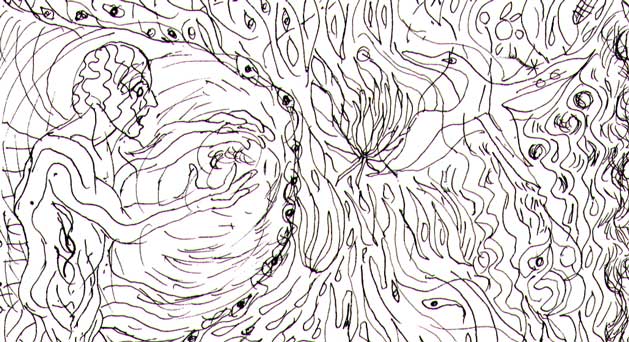
But the need for a metaphysic was very great, that is
clear to me. Once I had the vision my imagination worked overtime to try to
ground the vision in all that I was studying in world poetry, art and culture.
I created a fiction of embellished illusions and stitched them into my theory of
the veil. Before long I had created a whole philosophy about the Veil. The idea
of Samsara and Maya in Hinduism and Buddhism both are described as a 'veil'
behind whcih is the void or God, or The "Self" or Brahma. In Taoism there is the
concept of the ten thousand things, which is also sometimes described as a dream
or a veil behind which is the Tao. Rumi, the famous Persian Sufi states that the
"form of man is a veil" through which God shines. Indeed, the veil idea is
found in all the religions but is especially apparent i Sufism. Ibn Arabi states
in a paradoxical utterance typical of mysticism, that that "the veil that hides
Him is His own being". and he further states that
"His Veil is [only a part of] His oneness;
nothing veils other than He. His veil is [only] the concealment of His existence
in His oneness, without any quality. None sees Him other than He."
and then Al Ghazali, another well known
Sufi philsopher, explains that 'true
knowledge' is the consequence of illumination (ilham), of a divine
inspiration. Al-Ghazali says that
"when God takes
care of the heart . . ., the breast lightens and the mystery of the spiritual
realm is revealed, and the veil of error vanishes and the reality of
divine things shines in the heart"
This idea of god as something that exists
in an 'intelligible realm' behind everything is based on a self reflective narcissism,
as well as a political metaphor for a monolithic state or caste.
The inflated self mirroring involved in mysticism involves meditation,
prayer and mythic consciousness as a self-magnifying fiction. I was not able to
question this then. When I was doing the veil drawings, I was living inside such
illusions unable to see outside of them. I found, in my naive desire to believe without questioning, that my vision of
the veil had connected me to all the religions, which is to say it had connected
me to a sort of self mirroring delusion. I superimposed the Hindu,
Buddhist and Islamic metaphysical the ideas of Samsara and Maya on the
Judeo-Christian-Islamic notion of "creation" and from this I began to see the
idea of the veil everywhere and thus to imagine god or the resplendent void
everywhere. I saw the idea of the veil it in robes worn by the Buddha; the dance
of the veil of Salome, the veil on Veronica on which Christ's' face was supposed
to appear; the idea of the "iconostasis", the "veil of the temple", the mystery
of priest's vestments, the symbolism of weaving -- and I took all these aspects
of various religions and art and systems of thought--- and I imposed these ideas
on the idea of an invisible barrier between life and death. I did not yet
have the strength or insight to question the absurd, indeed, repulsive,
falsehood enunciated by various Sufis--- implicitly by Muhammad himself'' tht
'existence is a sin to which no other can be compared. This barbaric cult of
death and an implied hate of the earth and the subjugation of women is what the
veil is all about. The whole idea of "rending the veil" with its associations of
breaking through a young woman's hymen suppressed but present, became a way of
interpreting the entire world through the veil analogy. Rending the veil was
about seeking transformation, changing myself into a complete and total being.
The sexual implications of rending the veil come partly form magical, symbolist
associations with the labia as curtain, or a woman's hair or clothes as a sort
of fabric of longing, a metaphor for what is inaccessible but desired, hoped for
but still unattained. The esoteric was claimed to exist as an 'essence' behind
the exoteric as a woman's body is hinted at by her clothes. I did not yet
question the idea of 'essence' and how it might be a fabrication. I did not
realize that the whole idea of the veil or Maya and Samsara, was based on the
idea of hating the world as it is. Nor did I realize that it is a patriarchal
idea, born of misogynistic symbolism. But it will take some time to explain
this.....
I was trying to reach into the
ineffable the "beyond". I wanted to conquer death with my art and poetry. Conquer what had
killed my father. I did what poets and religions do, I imposed analogies and metaphors
upon my interpretation of the world and before long elaborated theories of Maya,
Samsara
and "creation' were imposed on the biological facts of veiling, half-light, the fluidity of being,
or
the transparency of a babies skin. I created the simple truth of a basic
intuition about biology and light and turned this into an metaphysical theory of
art. I did all this, only to have to undo it now, many years later.

"These endless knots that you tie and unite are chains of fire and form"
Why had I done this? Why had I imposed
a metaphysical ideology on a biological insight? Was it because of
the course on Eastern religion I took at Marietta college in 1975?. Was it
because of the book about Vedanta I read in that course. Or was it because I
had read Aldous Huxley's Perennial Philosophy that same year, or
because I liked Allen Ginsberg's Buddhism, or Rilke's attempt to cerate a
secular religion? Was it reading Rumi in 82 and 83? Was it because of a need to
escape the narrow views that science allowed?
| Was it my love of William Blake? Was
it because my father's death had deeply disturbed me? It was not exclusively
because of these reasons and experiences. I think it was for deeper
reasons. Much deeper reasons. The source of the drive of this need is hard
for me to determine. Did it arise from an early need to hide, a need to keep
myself anonymous, because only in anonymity could I be safe? Perhaps.
Perhaps it arose form a desire to share precious things only with those who
were likely to perceive what I had to give. Hide my candle behind a curtain.
Maybe the veil was really a fear of having my secret wishes mocked and
derided? Perhaps. Or maybe it was something less psychological, like
the need to find a way to the meaning of things, to go behind the curtain of
the illusions I had been taught as a boy. Maybe there was a real need hidden
behind the veil imagery, a need to cloak what I loved because in a time
where only money matters, my poor woven carpet of dreams and precious poetic
imaginings was unlikely to elicit kindness from others. The veil drawings
were my carpet of dreams and I feared all those who would tread on my
dreams. |
 |
The idea of the Veil led me
very far into the history and thought of the culture I grew up in. I wanted to
find my way back into the mists of where western art and culture come from and
find there what I called the "spirit of creativity". I needed to have a
comforting understanding of the world I lived in. I felt that the whole world I lived
in was threatened, a chimera, a delicate veil that would soon disappear. Maybe,
as Vincent said in one of his letters, quoting St. Paul that though "I see
through the glass darkly" one day "I will see full face". I wanted my art to
express this fullness of vision. I
sought through the veils of my own culture and history into the veil of other
cultures and I did not want to stop there. I thought the veil would save the
world or perhaps I thought that something "beyond the veil" could save the
world, we could all embrace the same imaginary mythos. For some reason, perhaps psychological, I needed to make my vision
universal. I universalized the veil idea, without questioing it in any realistic
or fundamental way. I wanted to believe that an individual vision that would save a dying world. But it actually
did not start out universal. I did not originally have these ambitious spiritual
aims. It did not occur to me that I was inflating my vision. Nor did it occur to
me that St. Paul was wrong, and the world is not a "glass" or the "mirror" that
Buddha called it. The vision of the veil was originally biological. It was not
spiritual or mystical at all. It began in biology.
When I look back into notebooks from 1977
and even before that I find references to the concept of the veil. For instance
there is this drawing from 1977, when I was 20 or 21, which is very similar to the passages written
above about the glimmer of water and light on grains of sand
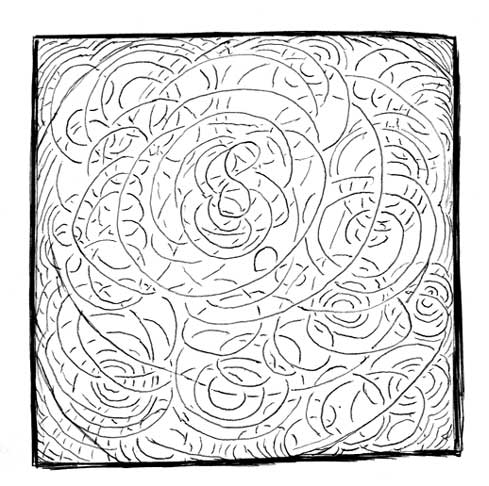
1"100 Rocks Hitting Water
100 Stars Shimmering
100 Sounds in the Air"
I was creating a mythology. The "Vision of the Veil" was a magnified
event that expressed a conceptual and emotional relationship to the world
that I already knew and had experienced. The idea of the veil itself was not new.
The actual "vision" was a simple intuition into the nature of the close relation
of human consciousness to biological facts. What was new, or added to the so
called vision, was the need to make the image serve a larger purpose. The vision
of the veil is really about mythic inflation and magnification of an image.
Religions of all kinds do just this: they take a real aspect of human life and
magnify and inflate it imaginatively. Then they fix the inflated image in
a story or series of stories which then become orthodoxies or oral histories
which it is forbidden to change or alter. I suspect that religious
experiences of all kinds are constructed in this way, more or less. A theme that
is above all emotional begins to develop in someone's life. One's father dies,
one loses a child, one grows angry and frustrated by poverty and illness. One
reaches for answers, supports and comfort. With time the story or
religious image gets invested with all sorts of overt and unconscious
resonances. Religions offer compelling illusions, ways to sublimate ordinary
human feelings and thought into abstract and symbolic magnifications. Love,
anger, the need of power are sublimated through myths and religions into
systems of social power and control. People begin to study these myths as
if they are real. Bureaucracy develops. Priests claim authority. Rich people
invest in the lie and the lie is repeated by the poor who need help. Suddenly,
there are dissenters to kill, unbelievers to slice in half, skeptics to
condemn with anathemas.
Part of this process happened to me after my
father's death in 1973. By 1979 I was ripe for a sudden realization that, in
fact, was really just a logical, emotional and imaginative eruption. One has a
"vision" which really is just an outburst of the obvious. Then that outburst
becomes a sort of false fact, a fallacy of misplaced concreteness, As Whitehead
called it.
I can trace back my "vision" to well before the Dec.
30th 1979 event. I had been constructing the vision in virtually every drawing I
was doing. I was often doing four of five drawings a day. I was writing poems
about it, and I even wrote a letter about it in September, 1979. So I was ripe
for it. The "vision" was just an auto-suggestion, as I believe are all such
"visions".
In the drawing opposite
I have not yet made the veil into a metaphysical symbol. It is still just
a lovely poetic fantasy. This drawing was done a month before the so called
"Vision of the Veil", I am calling
the Veil the "generative Veil" which is interesting, I am
already doing drawings as veils but without any explicit metaphysical
ideology imposed on them. The nearly invisible
woman in this drawing, whose eyes are closed in a delicate inner imagining
or meditation of some kind, hardly notices that around her are cell and
bone-like like
letters made of fire, faces, and organic shapes. A man, like an
aborigine or
Maori ghost, lays across her lap seeking some comfort there. Is that
me, laying over the lap of time, desiring to be comforted by the woman of my
days, the woman of nature, or the woman of imaginary peace? In this drawing
I seem to be seeking some kind of pre-linguistic language, a language of the
earth itself before humans begin to clutter up the world with vain talk. I
seem to be seeking for a way to speak beyond the bone and death, fire
changes, and the haunting of sufferers in a ghostly world time.
It is a drawing about seeking comfort and rest.
It is a drawing about love, and the veil
appears here to be a lattice of creative acts--- perhaps a parable for these
drawings themselves or perhaps an understanding that the progression of
days is a kind of hiding and revealing that opens and closes the meaning of life's
fires as flowers open their colors and hint at perfumes.
In any case,
it would seem to imply once again that
the notion of the veil as a "spiritual" symbol was a latter extrapolation.
Or, at the very least, my notion of the Veil was malleable to many
interpretations, some of them quite contradictory.
|

( Meditation: The generative veil draped over a woman, a webbed
lattice of knotted fires, like a curtain of days over creative acts,
wherefrom love burns a world's craving.)
|
This drawing is one of many that are
about the creative process itself. Here the image of the veil is combined
with the image of a woman potter. The woman is concealed behind her ideas
about pottery, which are interspersed between and a transparent vase she has
woven or spun or "thrown" or molded form her hands, as potters say. The
forms that issue form her seem to come from her body itself and resemble
birds or clouds. Her hands are "lacemaker hands" because what she does is so
delicate and fine. her hair seems to be woven too like the filigree of the
flower like vase she has made. She appears to bring the form into existence
and could as easily dissolve it. But she does not dissolve it. It grows into
something lovely and welcome. It is as lovely as herself, as lovely as a
bird, as lovely as the earth that gives birth to trees and flowers, birds
and humans, each one as lovely as the glass vase this woman has made.
This early picture-poem of a woman and the veil is
still an image of generative fertility. It is not yet a 'vision" over laid
with ponderous spiritual symbolism. |
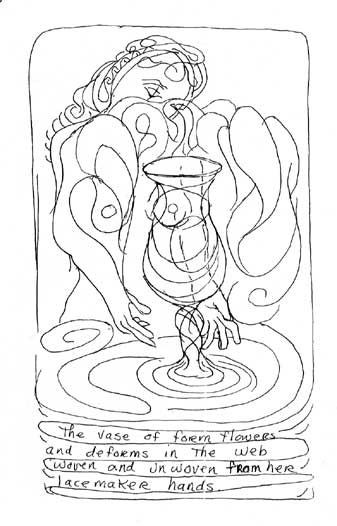 |
The later spiritual meaning I
overlaid on the vision of the veils are attempts to ground the vision in an
imaginative metaphysic, partly of my own making, partly derived from various
mystical traditions: as I have said, these include Sufi mysticism from Rumi and Hafez, for
instance: Hindu notions of "maya", the Christian notion of Christ "rending
the veil of the temple" when he died, Veronica's Veil, to Buddha seeing beyond
"samsara" and maya at the moment of enlightenment. But this is just for
starters. I universalized the idea of the veil and within a few years had made
it an image of nearly everything. Indeed, what I did is perhaps a good example
of how religions get constructed--- a simple, even mundane phenomena or
perception gets turned into a huge, symbolic intellectualized system for thought
and interpretation. I regret having turned my rather delicate and lovely notion
of nature as a veil into a metaphysical mythology. I can see why I did it. But
it was a mistake and led me in some harmful directions.
| Of course a "vision" is
little more than a strong inner imagining whose strength is emotionally
compelling. One can trace the elements of visionary experiences back into
influences form the past, aspects of ones educating, books one has read,
stories one was told or suggestions form other people. A vision is not, as
religions tend to insist, a historical event of an eternal and timeless
truth of being entering a message into time ( a 'torma'
or 'terma' in the Tibetan Buddhist lexicon-- a 'revelation' in middle eastern
monotheism). The myth of a "revelation" such as the idea of Krishna
talking to Arjuna or Gabriel giving the Koran to Muhammad, derives from
shamanistic hyperbole, indigenous people's vision quests, divine claims for
Bibles, Platonic conceits, politically motivated ideological symbolisms, mythic
constructions of knowledge/power. But the reality is that at that particular
point of time in my life, I needed a "divine vision" partly as a point around
which I could gather and protect myself and into which i could project my
concerns and interests. If only I had an ultimate meaning, an everlasting
radiance that could give comfort to my loneliness and answer the question of
my suffering. I wanted to be free of death, to live in an ocean of
light. No one is free of death. There is no ocean of light. There is only
light on the ocean. My need of god was a great longing and a deep love born
of a mistake in my awareness. |
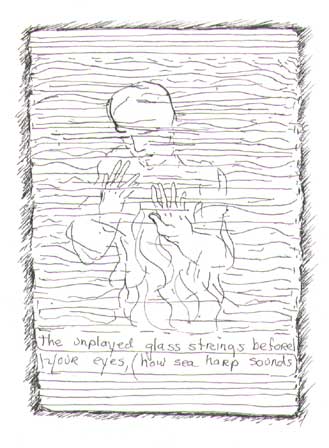
The Unplayed Glass Strings Before Your Eyes
|
I can now see that this is what happened and that
my vision of the veil was a sort of psychological dream friend, a sort of
imaginary security blanket. It is much harder for an entire culture to realize
that such images as the fiction of the life of Jesus or the tales told in the
Koran are little more that make believe, half truth half lie, sophisticated
fairy tales of adults and children alike. Religions are systems of thought-dreams meant to control people's behavior and set up a regime of punishments and
benefits.
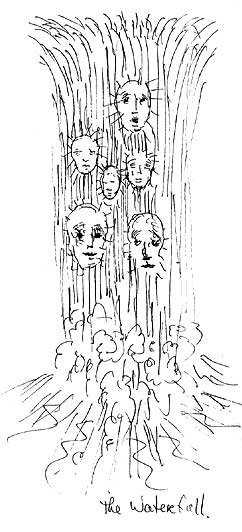 |
The
idea of veil fails in the Philosophical Drawings. It is a beautiful
failure though, like any well lived life that must inevitably come to death.
I can see that now, just as the dream-vision of religion itself failed me
eventually and I gave up religion entirely. I think that for some years I
knew, in private moments, that the veil imagery was based on an illusion,
but I was attempting to hold up the dream vision of the Veil anyway. I could
not face the failure. It was a compellingly beautiful idea. I was drawing a
world that did not exist in an effort to reflect on the world that does
exist. I think it was Blake who said that one needs to "keep the divine
vision in times of trouble" and this is true--- though now I would drop the
adjective "divine" and simply say that one must hold to what matters and
what matters is simple beings on earth, both human and non-human.
What the Philosophical Drawings document is the struggle to persist in mythic imaginings
despite the encroaching failure of the mythic. It is a book about twilight of
the gods, which is not yet conscious that the gods have died. But at the same
time, the Philosophical Drawings do not yet descend into the closed
mind of religious ideologies. The veil in many of the drawings is a living
thing, like a waterfall. Like the waterfall of faces in the drawing the veil
is a whispering poetic idea, a veil of whispers, like a waterfall of voices.
Many of the drawings are "veils", in fact, the
majority. A large proportion of the Philosophical Drawings are drawn as
veils, or as delicate curtains or transparencies which both hide and reveal
their meanings. In many, even most of the drawings this is a harmless fact,
which does not have any negative effect on the drawings. |
The following drawing, from 1979, is a good
example. It is abased on some conversations I had with Jack Hirschman about the complimentarity of chance and destiny. Jack had been influenced by some aspects
of Marxist thought to believe that destiny had some sort of determined
historical meaning. But at the same time, he was often working with chance and
free association in his poetry. I was trying to grasp how opposing ideas found
rest in creative solutions to insoluble dilemmas. So in this drawing I was
trying to reach around difficult concepts and grasp them in a simple and
elemental way. It is a drawing about creative peace, about a voice or a way of
being that neither
denies chance nor entirely endorses determinism. The man in the drawing creates language in
space, and envelopes himself in nature even as he is able to grasp
elemental ideas and create crystal-like geometric forms, such as the one he
holds in his hand.

Intuitive Transparency
The bird flies one way and the man's
motion moves another, but the two motions are not out of balance. The amn has
acieved a balance in a kind of
dynamic rest. This is a man in tune with himself an with nature. The over
arching title of the drawing, does not appear here, but it does appear on the
sheet of paper in the notebook in whcih this drawing occurs. The title is
"Intuitive Transparency". The title sums it up a biological idea of the veil as a membrane
of actual existences. Nature is intuitively transparent. It is not quite yet a
metaphysical world of imaginary abstraction and gods. Nor is it the arena of
scientific fact searching. Nature is not science or religion but something more
basic and primary .
|
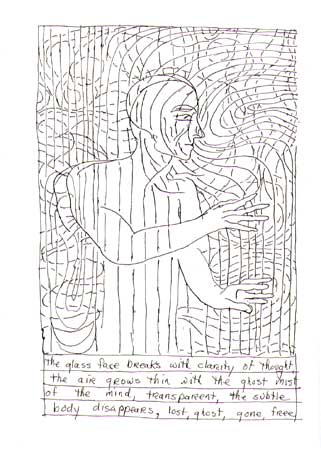
The Veil and
Clarity of Thought
|
The veil drawings are not all
uniform and explore a variety of meanings and suggestions. Some of them attempt
to be "tantric" drawings. In Buddhist terms they seek to picture Nirvana in
Samsara, or to see the void in the ten thousand things, the emptiness in the
plenitude. All this is a rather pretentious way of saying I was
studying my own consciousness. I was studying religion or metaphysical
ideas as a form of poetry. The notion of veiling is generally assumed in the
style and technique of the drawing itself, as indeed, the whole notion of
'technique' is conceived of as "weaving". ( the words tantra and the technique
are
both words that originate in words for weaving). There is a
chapter in the book Saint and the Blindman, specifically called the
Veils, which contains many drawings about veils and veiling. I have spread
some of these around this essay. The one to the left is one such drawing and
it is a meditation on thought and space. I imagine a man mad of glass, but
the glass is so thin that it is as if it were transparent flesh and in the
midst of this a man reaches with his mind into space. The motion of the
lines behind the veil passes through the man and through the air. It is a
picture of consciousness of space and the feelings of being in a world where
space is around us. The feeling feel out of himself into the world around
him. He seeks for some kind of liberation. |
This drawing is also about consciousness, but this time there is an
animistic relationship being drawn between thought and nature. The man
thought actually rain down into the bowl from the clouds around him. He
offers the bowl of his collected intuition to the viewer. This is one of
many drawings about giving and gifts. Here the man has revived from nature
many intuitions and understanding and he wants to give them to others. I
have often felt this way in my life and this is something of a self
portrait.
My "Vision of the Veil" is not "true", that is, not
compelling to me anymore, though I retain a certain admiration for its
logical and intuitive coherence, and its imaginative application to the
aesthetic philosophy at the basis of these drawings. What I mean by
this is that many of the drawings are very beautiful or if not exactly
beautiful, the conceptions they evoke of beautiful. I feel the same
way about religion and systems of symbols in general, I admire
imaginative flights, mystical creativity, but I realize that the motives
behind such flights are what matters. I don't believe in delusions even if I
can admire their beauty in some cases. The symbols are not real, but what
generated the need of the symbols is real. Hindu or Christian gods are
fiction, the need of the gods and the social network that sustained them are
real. The drawing opposite shows something of the reality of one who views
nature and loves what he views. Someone who loves nature ants to give of
what he loves to others. |
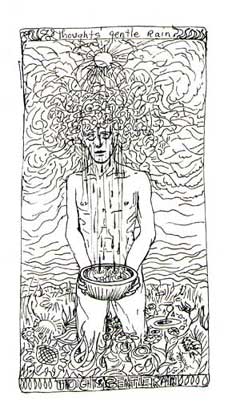
Thought's Gentle Rain |
People create and sustain gods out of real
needs. That is why people who leave religions or cults out of
disillusionment with religion suffer so much. It is
like finding out that your father is a criminal, or your mother is not your
real mother, or your best friend has been cheating on you. Religion can only
work its magic it it can engender trust. Once the trust is destroyed the
system of belief dies in the heart, destroyed by betrayal. In this sense
religion is a veil, a chimera, a mirage that hides a strategy.
We want a god who is loving or who renders justice for us or who protects us and gives us
security. The gods are images of us, and our social and psychological needs
and projections. I was using the veil as a means of projecting my needs,
conflicts and resolutions into artworks. Art is a veil, as Shakespeare said,
not a mirror, and there is truth in that. People believe that they need
religion. They don't actually, but like any well worn habit religion comes
eventually to seem indispensable
I thought I was blind for along
time, and in some ways I am. But I have learned to be skeptical of those who
most claim to see, including my own claims to certainty. Those who claim the
greatest knowledge sometimes are the most blind and those who do not see
sometimes have real vision. Why did I picture the very attractive
female as the one who is uncovering and restoring the sight of the blindman opposite?
Or
is she obscuring his sight?
|
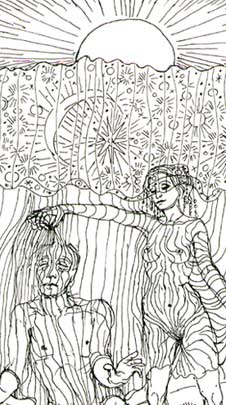
Blindman Veiled
|
I admire the aesthetic creation of the idea
of the drawings as 'veils" even if I think it is mythical nonsense with
only a loose connection to facts. It is a poetic theory nonetheless and one that
has some interest as a creative summation and synthesis of world wide aesthetic
and mystical theories, since I was deliberately trying to
unify Hindu, Buddhist, Sufi, Tibetan, Christian and Indigenous notions of art.
In some strange way I was trying to grope towards replacing the dominance of
theories of knowledge (epistemology) with a theory of how to see (an aesthetic).
Of course, I know longer believe in my veil theory. But it does provide for me
an example of how theories are created. Religion, like science offers a theory
of the world. But religions offer theories which are fabulations, which might
correspond to reality in minimal ways. Science must prove its theories and
hypotheses. But much of religion corresponds to no reality at all other
than an imaginary system of beliefs with no factual basis. There is no heaven or
hell and no one has ever proved Christ resurrected or Buddha slayed death and
desire. Such fabulations serve power interests and become dogmas that continue
to be unfairly taught or imposed on people. In contrast, art is not confined to
religious dogmas, at least in our time. The veil of Isis is a lie. Isis is not
Atma, the Veil is not Maya, all that is an elaborate mythology created by a male
priesthood reducing women to a metaphysics of nudity. There is nothing wrong
with nudity, but I have given up Tantric, Sufi , Hindu and Christian notions of
veiling and removal of veils, clothes or appearances. There is no essence: no
beyond. A nude woman or man is not a symbol. There is only this earth. I can reject my vision of the veil as a fabulation, without
ceasing to admire some of the art that come from the idea. Art is, thankfully,
no longer under the thumb of religion or political powers, as it once was. So
called "sacred art" was little more than propaganda for a religious, political
or aristocratic elite. The overthrow of the idea of the veil turns out to
correspond with the overthrow of the ideas behind religion and mythology. This
does not mean that some of the art of Sienna or Islam is not beautiful. I still
love Oriental Carpets. I still love aspects of Klee and Kandinsky, without
accepting their notion of art as mysticism.
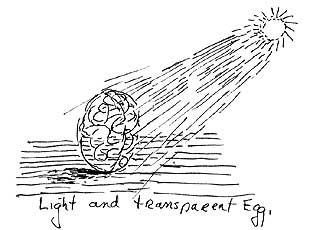 |
In the days of these drawings I saw philosophy as dominated by Kantian/Science and all the
emphasis on
"Knowledge" as a means of oppressive power seeking.
I thought that perhaps art could gives us another way of looking at the world
that was not dictated by science or religion. I still think this is true. There
are many ways to see the world, and art can explore these many ways. The
light that passes through a transparent egg is poetic and beautiful, quite
apart from he excesses of Hindu or any other mythology. |
The
failure of the 'vision of the veil' shows me that art can seek to approximate to
reality and correct itself. The veil drawings still have some validity, not as a factual presentation of how
reality actually is put together, but as a poetic and personal mythology born of
my own desire to create a world that is worth living in. I created a
fictional universe, not just on paper, but one that I was a main character in,
within the novel of my actual life. This is what art does. The fiction I created, is, in some respects,
more real than 'reality', if reality is conceived of as a disenchanted wasteland
of money experts, accountants and banker trying to strangle existence on earth
to profit an elite few. The world that is created by bankers. politicians,
lawyers, priests, Wall Street and Hollywood is in many respects a lie. To climb
over the wall of the world these lies create is a good and just ambition, even
if it fails. But
one has to be careful that one does not make another wall that separates oneself
from reality. There is a 'real world" however much convenient
facsimiles and deceitful constructions of reality created for other motives
might intrude upon a fair
and sympathetic understanding of existence. Religion is fiction, though it is
based on some psychological facts, science is factual on the surface, though it
is highly highly conditioned by psycho-social factors. Art can learn and change
and seek more accurate ways to show the world toward others. Since my vision of
the veil failed I have gotten up and created other and different views of the
world, hopefully more accurate each time.

Yearning to go Beyond the Wall
(detail of Wall of being rock of Conscience)
When I was 14 my parents moved us to a new town. I had trouble adapting.
There had been too many previous moves and I couldn't take it anymore and
withdrew into a shell.. I thought there must be some way to get back to my
friends. maybe i could fl to them by magic. At age
15 I thought that there had to be some way to go beyond the prison the new town
that we lived in. One of my first paintings was of a fool or clown dressed in a
red and white stripped tight fitting costume. The clown stands next to a black
wall and beyond the wall is a beautiful landscape. The panting
asks the question of how the fool might to get beyond the wall back to the
natural world where harmony and peace can be found. My youth was so much
involved with the ntural world that the new city we lived in seemed a cultural
prison to me, separating me from my earlier past.
I saw much of what is called philosophy as such a wall,
even though my original reason fro searching into philosophy was to get beyond
the wall. I learned early that philosophies obstructed perhaps more often than
they liberate. I wanted a philosophy not based on power but on care
and beauty. I wanted to go beyond the bloody Wall of the Zietgiest, the dominant philosophy ot the times, beyond Kant and reductionist
science. In the drawing 'Wall
of Being, Rock of Conscience" a man is trying to reach forth
beyond the wall of suffering and death. It can't be done of course, at least not
in any ultimate way, but the promise that it can be done is the stock and trade
of religion. But quite apart from the illusions that religions can provide to
comfort humans, i was seeking some way to transcend the oppressive mentality of
the view of that nature exists as nothing more than an meaningless and
exploitable mass of "brute matter" that exists for humans alone. As
much as I had loved aspects of science when I was a kid, I grew very skeptical
of its negative aspects throughout my twenties.
| I had a hard time seeing much
redeeming value in science at all for many years. I loved nature, but
found it hard to see the nature that I knew in the mass of information
industry uses to exploit nature for human greed. The image of the wall
beyond which I am kept imprisoned by a mentality thus occurs in various
contexts. So for instance did this tiny drawing, actually a very small
sketch perhaps three times the size of a postage stamp, I show a man
"scratching at the walls of science". |
 |
Of course, I now am much more sympathetic
to science, or at least to open eyed inquiry that is done with sympathy and
within an ethical framework. Much of what goes by the name of Big Science, done
by the military or genetics companies is inquiry for exploitive motives. In
any case, my effort to face of the "wall" occurs in various contexts. In 1979 I wrote a
poem called "The Confusions of Immanuel Kant", which states, for
instance:
Kant know(no) religion
can't know(no) art
can't know(no) science
can't climb nor see beyond white wall
can't see through the littered language....
(click
here for entire poem)
I was trying to reach beyond the world as defined for me by science and such orthodox modern
philosophers as Kant or poets such as Rilke, who I was reading deeply around this
time.. I wanted to reach beyond the colonial imperialism of "America" beyond the wall of hate and
injustice and knowledge, beyond the world of cruel business and competitive greed
that my father had lived and died in.. That is partly why I was attracted to Jack Hirschman,
whose knowledge of many languages and whose connection with a world poetry
movement of liberation enchanted and informed me. To get beyond the "Wall" or the "Veil" was about
wanting to see beyond myself, beyond the world defined by those who claimed
exclusive rights to ownership and knowledge. Put this way there is nothing wrong
with such a desire. The image of the
veil became a means of
creating distance between myself and the world around me that I saw---not
without good reason--- as
threatening and dangerous. But I now realize that I was participating, however
unwittingly, in a transcendentalist and part German, or at least Romantic notion
of "going beyond" , a somewhat secular notion of gnostic flight from a world
seemed cruel and heartless. I was right in the heart of the Romantic desire
to penetrate the mysterious and find freedom in the unknown mystery of the sublime.
The ghosts of Rimbaud, Novalis, Blake, Emerson, Shelley, Heidegger and Rilke hovered around
me like deceptive specters. So for instance, some months before the "vision of
the Veil" on Dec1979, I find myself writing in a letter of Sept 79 that "I spent the day reading at City Lights
and writing and drawing in a Cafe and I am dissatisfied with my art.....I cannot
reach what I wish to". And I define in the letter that what I feel
considerable dissatisfaction
"on account of, how shall I say
there is not enough light bleeding into this darkness, not enough sound in this
nether land.... It is a desire to somehow reach my hand through the veil and
touch the hand of one who is exists behind-- ultimately it is a desire to reach
that being behind the veil who would pull me into the other land, --but as
humans rarely, if ever, are able to enter this realm while living, I should be
content with holding the hand of one of these pure ones--- who could pull me
close to the veil and whisper all those things that I wish I knew and
understood, but do not know or understand"
This letter is written around the same time as the Kant poem and just as I am beginning to
do the veil drawings with increasing urgency. This is pure romantic longing, a
desire to pass through the curtain of time into an imaginary eternity. This
longing
hides something a death wish in it, or perhaps a monastic or poetic otherworldly
decadence or perhaps a derive toward some world of complete and totally
satisfying knowledge of things. It is a desire born of my father dying and
my own loneliness and reading too much Shelley, Rilke or Mallarme. At this point
I had not read much Plato, but I later would and I came to see that I had been
inadvertently influenced by a deep strain of Platonism that flows though western
poetry and art. There is a strong element of earth hatred in the idea of the veil. I
should have recognized that the idea of the veil involved the denigration of the
actual world as being a lesser realm of sin and death, the "wheel of birth and
death" so much looked down on in Buddhism. The story is told that
once, when
Muhammad saw a dead goat he is reported to have said, “The world has lesser
value in the eyes of God than this goat has for its owner.” Which means that the
world is trash, a corpse. This is a horrendous attitude and partly why I could
never be a Moslem. When Muhammad
castigates the world as being less than a dead goat he is not just insulting
goats but denigrating the actual world by holding up an imaginary pure world beyond as an fictional exemplar. I
have come to dislike this denigration of the real world and think it responsible
for many of the ills form which our earth suffers. In another pronouncement
Muhammad says that "And He [god] has made subservient to you whatsoever is in
the heavens and whatsoever is in the earth, all, from Himself;". This is a
typical speciesist claim that states that humans are far above all other species
and the earth itself. This attitude, akin to racism and sexism, is common to all the religions in
varying degrees, is partly why I left religion and will not return to it. There
is no veil, nor world beyond, there is only this earth where we live and suffer.
I see now that need of the veil was
real, that is this actual world was real-- but the veil itself was a fiction. In
short I was beginning to create my own religion, and in retrospect, I can see
how this eventually led me into some harmful relationships and dangerous
circumstances. Visionary and imaginary systems of all kinds become prisons
eventually. Eventually the "Vision of the Veil" would lead me into joining
a religious group that was harmful to myself and others. I came to see that
those who claimed knowledge of what was behind the veil were charlatans. The
veil did not lead me "beyond" but rather lead into a suffocating trap, the lair
of a spider. I had to tear the veil down, pull back the curtain and show other
the fraudulent charlatan behind it. I was like the dog 'Toto" in the
Wizard of Oz. I exposed the wizard for the puffed up fraud that he was. Ripping
down the veil showed me that the veil itself was the illusion.
Knowledge as a means to obtain power over others for
unjust purposes must be resisted wherever it is found. I resisted the power
and knowledge of religion once I finally understood the injustices of it,
but it took me many years and much study to come to understand this. The
Philosophical Drawings were done at an early stage of this inquiry, and thus
are still exploring possibilities and asking questions about things I did
not yet understand as I do now. For me, the Philosophical Drawings are
artifacts of the organic history of growth of my own way of seeing the
world. They are, fortunately or unfortunately, fallible, transitory,
pictures of frames of mind and perspectives that appear certain, but
actually are uncertain. The Philosophical drawings are not the "truth" of
the matter. they are merely explorative attempts to depict a flawed and
fallible vision of the world.
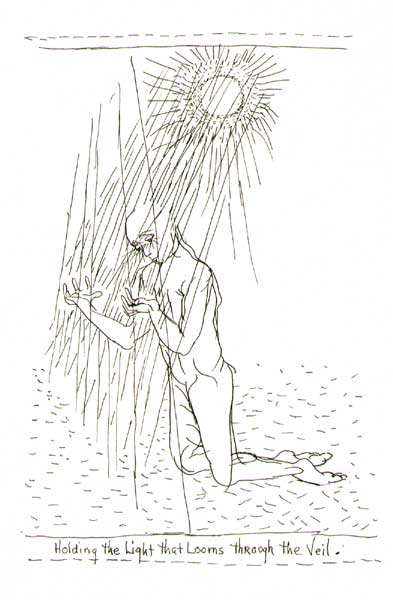
Holding the Light that Looms Through the Veil
It would be a mistake to see these drawings as "Icons", since Icon's such as
Christian Icons or Tibetan Tankha's claim to represent and eternal reality and
thus offer and window into the transient world of ordinary reality. These
drawings were in some cases attempting to picture such a realm, but at the same
time they were questioning it, and in some cases denying it. My own view
now is that these drawing ultimately reject the gnostic or Iconic view of the
world.
Some of these drawings seek to create
the impression of an eternal world, and sometimes they even succeed in this. I
had studied methods of how to present and depict imaginary 'real' worlds in a
style that enchants and calls upon longings for eternity. But that is the nature
of artifice and imagination: I conjure the eternal out of the ephemeral. "
Art wants to create the finite that restores the infinite" Gilles Deleuze says
in his What is Philosophy (pg 197). I agreed with that twenty years ago.
But do believe in that anymore. Infinity in art is a conjuring trick, a play of
mirrors, and immersion in a deception of abstractions and symbolic ambiguities.
What matters to me increasingly is care for the finite, the living detail of the
actual, the eyes of the bird, animal of human that wants to live in the world. Infinity is vain
reaching after totality. I do not care for infinity or the pose of eternity
anymore. Care of the finite is the love of actual beings and that is what
matters.
| There is no true "eternity"---
there is only the illusion of it in art and words. "Eternity" is a
linguistic trick, a bit of metaphysical sleight of hand, a mirage made of words and self-reflective ideas. The
desire to reach beyond the "Wall of Being" is a human desire, but it is
unrealizable, since nothing is "beyond being". The concept of "beyond
being" or "being as such" is merely the empty
mirror of an overwrought imagination. The Philosophical Drawings depict a
mind on the edge of ardent, unbalanced and desperate hopes, born on
the edge of despair and nuclear night. The style could not be sustained
indefinitely. It was, in some ways, a beautiful lie. Part of me knew that.
Part of me knew the Veil was somehow an illusion, a strategy of covering and
enticing, hiding to reveal. I was the Blindman that appears in these
drawings, who wanted to be a Saint, until he realized that Saints are
fictions too, advertisements for religious institutions. Now I see myself,
to the degree that I can see, more accurately, I hope. I am a person
who is not blind perhaps, but who has imperfect vision. |

The Blindman |
 |
Religions try to teach their
followers to despise themselves, to see themselves as having an inborn bad
karma, or of being the worst of sinners. Capitalism tries to teach its
victims, who are referred to as "consumers" that they are hateful, inferior
beings. Only the person that has the most products, "new and improved" is a
good person, all the rest are 'old and archaic'. I do not despise myself
and am neither a capitalist or religious. I am neither a saint nor
blind, neither the worst of the worst nor the best of the best, but rather,
one of many beings seeking to live with other beings on a wonderful earth. I've
learned so much from birds and animals. One thing i have learned is that
their lives are self contained. They love their worlds and live in them as
well as they can. Geese have an amazing integrity and individuality, for
instance. Yet they need no gods nor do they try to exploit or destroy the
rest of nature as humans do. I am thinking about expanding humanism it to
include 'animalism' or 'earthism'. Beingism? |
After
I gave up the beliefs in the actuality of my vision and the "veil"
largely imagery
disappears from my life and work. Though I must say that in some of my nature
paintings of the last 5 years, the notion of nature as a veil has disappeared,
but the notion that there is a meaning within nature persists. The evidence of
what I have experienced of nature suggests to me not that nature is a "veil", but
rather,
that there is no meaning behind the veil and thus the concept of nature as a veil is
meaningless. The resplendent tissue of light and air that shimmers with twilight through
mist and clouds and hovers over rivers and quakes with rainbow colored
leaves rustling with autumn breezes-- all this is a not a "veil". The
meaning of nature is itself. There is no god that guides nature, no god that
guides evolution.. No "hidden hand', no "creator". There is nothing beyond
nature. The meaning of the rustling of leaves and the rainbow of morning light
is the rustling of leaves in the rainbow of morning light. This is all I need,
indeed, it is much more than I need. This is the world
that sustains us and that we live in as grateful members or the earthen
community. There is no heaven or hell. Sorry, William Blake, your dream of an
eternal imagination was profound and interesting, but I see things otherwise
now. You told me to think for myself rather than be enslaved by another man's
system, and I have done that. I am not the slave or Blake's system or anyone
else. Freeing myself of the veil freed me to see nature as best I can, with
whatever imperfect vision I can muster.
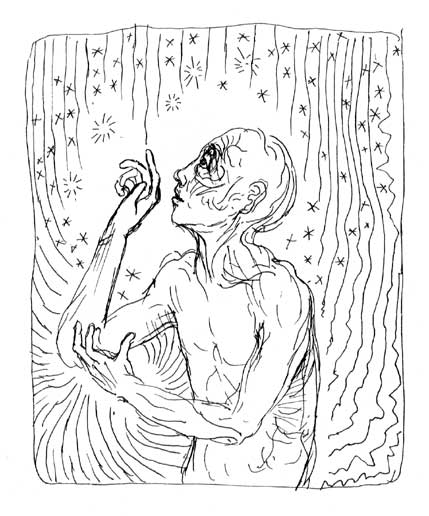
Veil of Midnight
(touching a single thread of being)
I abandoned the language of "Creator/creation"
over ten years ago because this construction
is denigrating to the "created" side of the dichotomy. There is no
"creator" and thus no "creation" implied as belonging to or
issuing form a "creator".
There is only this world of stones and people
and love and seagulls and clams, which belongs to no one and everyone. The world is not "created" not demeaned by
derivation, not secondary, not property, not a "materia secunda" and its mystery is not to be seized and
exploited or owned by an anthropomorphic deity or by those who claim to buy and
sell in his name.
I must say that my "vision",
questionable as it is, is explained and explored in an impressive series of
essays or assays, as I called them. I describe the aesthetic theory I
developed in 1980-81 in an essay I wrote in 1981 for the book of drawings the Saint and the Blind man and further
explicate the theory in a short book called
Language and the Veil.(1984). This was my first attempt at a full length
treatment of a subject in essay form. It is wildly youthful, aphoristic, and
embarrassing on many levels. It has flashes of real brilliance amidst the
rhetoric, the polemics and the youthful illusions and enthusiasm.
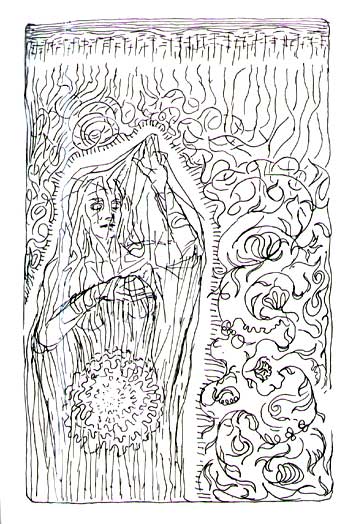 |
It outlines my
theory of the veil as a theory of aesthetics. The book is interesting as a kind
of "outsider" essay, written with real vision on the one hand, but full of
immature and
mistaken ideas on the other. On the other hand, I think that the writing I did
between 1984 and 1990, which is my 'religion period' is the worst work I have
ever done.
The description of the Vision of the Veil itself occurs in a long work
that I have been calling Deconstructing Faust (1980). and a series of
poetic works one of which is called Language I ( 1981) and a series of
more essays done around the same time, one of which is called Color, or the Seven
Colored Princess.(1983). All these works are passionate and mistaken in one
way or another. But there is certainly truth of an autobiographical nature
in them. They are the works of a struggling, immature mind. They are the
record of a searching mind willing to make many mistakes to find his way.
|
Throughout the period of 1979-1982 I
worked on a long poem called The Nameless One and this too employs the
concept of the Veil in various ways. The Veil is also discussed and negated in the long
book I wrote in 1986 called the Last Man. This book was written and
subsequently criticized between 1991 and 2003, the criticism written on facing pages.
The two books of Poems written during this period, The Sophia Poems and the
Point
Reyes Poems both employ veil symbolism. The period from 1979-91 is so dominated
by veil symbolism that I could call it my Veil decade. Indeed, it could be
said that the Veil idea originates in biology in 1979 a and dies in religion in
1991. The 1990's were my
unveiling decade, perhaps, were I meticulously took apart most of what I made up in
the 1980's, increasingly abandoning the realm of power and knowledge and finding
myself concerned more and more with nature, intimacy and rights.
Thus my drawings are nested in this complex of intellectual
labors, and in a certain sense, they are the engine of this labor, in that my
art work has always had a certain priority over what I write. They express
an ongoing debate over how the world might be viewed. I can't
possibly reproduce all these writings here, obviously. I mention all this supportive work
because it is a fact that these drawing were done in conjunction with
poems, essays, journals or
philosophical research that would continue up until the present. It has taken me years
to understand aspects of what i was doing in 1979-1984 since my beliefs
and concerns have changed radically since that period. So writing an explorative
essay to frame and explain aspects of these drawing 20 years after they were
done is not such an odd thing, after all. Reading meanings into these drawings
that may have been unrealized or unconscious is also not unreasonable. With many
of these drawings I was not sure exactly what the meaning was when I did them
and even now, there are mysteries about what was and is meant.
For instance, I will now
consider three drawings. All three of these complex drawings images of transcendence, or I though so when I did them. They picture the same yearning for
knowledge of an imaginary beyond that I explored in the poem "Confusions of Immaneul
Kant".
I will explain these images one at a time:
The first drawaing, is
Wall of Being, Rock of Conscience
...

The Wall of Being, the Rock of Conscience
It is a very complex drawing which shows two men and a
cat. One of the men is trying to reach beyond the wall of being. He can't,
of course. No one can reach beyond being. The idea is absurd. On the right side of the drawing there appears to be a man,
inside the wall of being, who is wrapped up in some kind of rope or cloth
and behind him appears to be an enormous seashell. Is the man being born? And
next to him is a mysterious woman, who appears to be made out of water and
seeds. She has her eyes closed and is smiling. It is a lovely image, this woman
of wter and seeds of what might be possible.
| The young man, sits on a rock that disappears into an abyss. He is trying to think, intuit or project his way beyond the
'Wall of Being'. An
eagle or hawk flies with his insight or perhaps the eagle is his insight. A beautiful image, conceptually speaking,
a kind of longing for home sought within ones own heart. It reminds me of how I
felt as a very young man when my parents moved us from town to town and I would
lay awake night trying to project my heart and mind back to the friends I had
lost in the town we had moved from. If only I could fly in my mind through the
air and return to my beloved friends. The image is neutral in its meaning. But I
question now the desire to "penetrate" nature that it exhibits. Why did I feel
this ceaseless need to go beyond, to "breakthrough", transcend and go
further and further? There is no need to "penetrate" nature. |
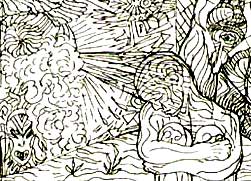 |
What is the end purpose of such gnostic ambitions and scientific progress
? Is
not such yearning ultimately a kind of destructive and acquisitive greed?
On the other hand, what is the wall of being? There is nothing beyond being. The wall occurs as a symbol in my earliest
painting where I pictured myself as a sort of clown trying to get over the wall
separating me from nature. There is no real separation. The feeling of
separation is cultural and due to language and an alien mentality that is taught
to us by culture. What in my education made me think that there was something
beyond being?. Nietzsche prattles on about "overcoming". But Nietzsche got this
need to 'go beyond" from somewhere too. The concern with the beyond is
about power, about controlling what matters. Actually there is no beyond, There
is only this world and this life. We live once only and then no more. That is
why it is important to value the world that is here. The death of God is not
tragic. With ideologies of the beyond gone we can begin to care for the
marvelous world that we are born into. This is all we have, so we need to make
the best of it.
The next drawing also deal with images of the veil and penetration.
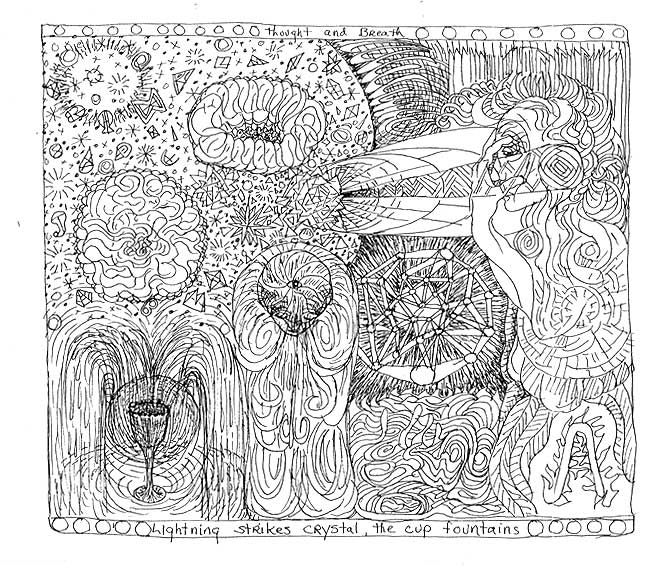
Thought and Breath: Lightning Strikes the Crystal, the Cup Fountains
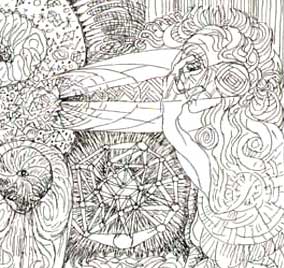 |
This drawing shows a very impressive, idealized man, perhaps a Magi, a monk, a
philosopher-poet from another age, who is thinking deep inside himself and
trying to meditate and penetrate through the veil of ignorance, and become
enlightened. His penetrating thought is opening the veil and shattering a
crystal into light.
Thought and Breath:
Lightning Strikes the Crystal and the Cup Fountains,
is the title. It is an exciting image for me still. The image of thought as
a crystal that is entered into by a penetrating intuition has a certain
appeal in the same way that arctic ice or thoughts of precious stones filled
with sunlight excite and appeal the mind. The sexual suggestion of
penetration might have some meaning here. It might not. But I am sure that
part of this drawing derives from Buddhist imagery, specifically Tibetan
Buddhist imagery. |
I had studied Buddhist art around
this time and was very interested in images of the Vajra, the sword of light and
insight, the penetration of the "diamond essence" of the mind, the
lightning that
strikes the crystal and illuminates it with ultimate understanding. There were
some amazing Tibetan sculptures or statues I had seen in the Tibetan museum on
Staten Island where the bodes of male and female Bodhisattvas were made of
colored jewels and precious stones. and their clothes made of metal. This made
their bodies look like they were full of light, like slight insside rubies or
quartz crystals. The notion of 'presence' in Buddhism and the symbolism of
mirrors and crystals has some meaning here. The idea of the body as a temple or a jewel or crystal full of light
seemed to have a certain truth contained it it. Shattering the jewel or the
crystal mirror had a certain liberating quality and I imaged this as an image of
freedom or enlightenment. But again, this freedom or thirst for enlightenment has a
price. The image of the Magi is one of otherworldliness and denial of the actual.
The need of possession of total reality, of an idealized world of "Mind", is a
result of a greed at the heart of religion that has largely been unquestioned.
The whole notion of penetration, shattering the crystal and piercing the veil
employs a patriarchal and sexual symbolism that implies harm or violence. This
is questionable and is partly why I decided that religion did not really tell the
truth about the world.
The third drawing shows the Veil as a "Stairway of Silk", very lovingly
drawn.....
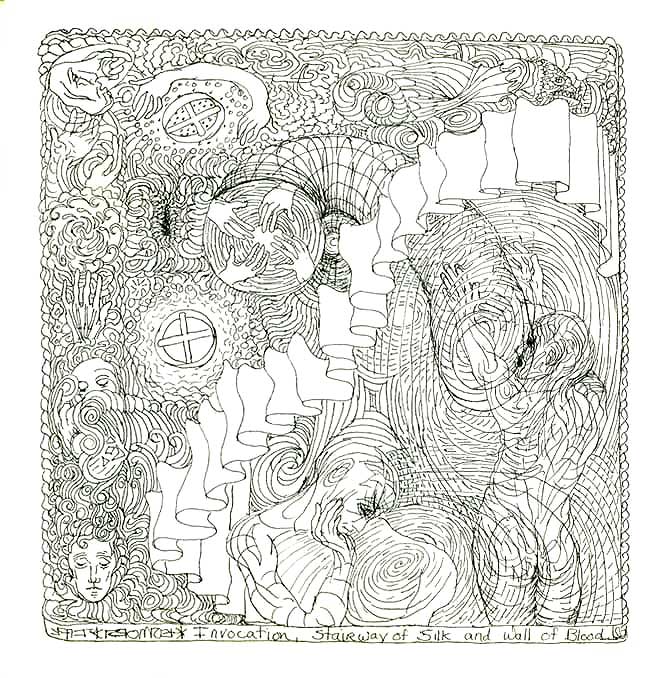
Invocation: Stairway of Silk and Wall of
Blood
One man seems to be looking into a veil or
pool inside himself and the other man is reaching into a space that goes beyond
the veil. The a man trying to reach beyond the veil, and
beyond the veil of silk, reaches toward what appears to be circle with
four hands reaching toward a center. This is an image of unity. But this is one
of the strangest of the veil drawings
Notice the title of this drawing
"Invocation:
Stairway of Silk and Wall of Blood". The wall of blood is here
conceived as being what is beyond the veil and this begs the question: what is it in the
transcendental
desire that is destructive, opposed to life, bloody and unjust?. The wall
of blood that is beyond the veil is made up of various kinds of what
seem to be entangled beings. A man reaches for answers to unanswered
questions. A dismembered hand reaches into a spiral of rain. The notion of a
spirituality that is beyond "flesh", beyond the organs of the body, beyond actual
matter, is absurd. The overvaluation of bodiless or unembodied thought or insight
is destructive to the earth and to actual bodies. This appears to be a drawing
of the veil that questions the idea of the veil itself. |
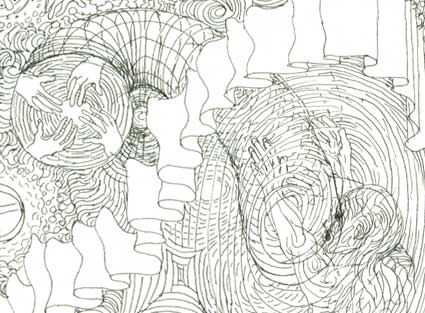
|
The mystery of these images of transcendent
desire is not the spiritual symbolism, which I studied for years and understand
well enough. The mystery is what was this transcendental desire all about? Why
did I desire union with something beyond time? Why do humans need another world
beyond this world ? Does not the desire for another world eventually cause
violence to be done to this world? What a strange concept. "beyond time",
"beyond death", "life beyond life"? Escape from time is illusory at best, but, I
suppose, even an illusory escape provides a certain comfort. But what these
drawing reveal to me now, in a way I only dimly understood when I did them, was
that the romantic and spiritual desire to "go beyond" to "overcome the world" or
to achieve "enlightenment" or a primordial state of mind and being that was
always the same "from the beginning" is essentially an unnatural desire, a
cultural construction, born in the mists of history---born in fears and hopes and
cultured by shamanistic practices and eventually rarified into a system of
priestly and institutional structures. Indeed, thre is probably mno more
destructive thing in history than the creatin of these symbokic and abstract
systems of religious fictions. I have given up such desires. I want only
this earth, these hands, this actual place where I am, where flowers grow, where
my wife lives, where my baby is born.
What is sometimes called "sacred art" are images codified into a regimented
symbolisms used by institutions. These are images of power tied obliquely to
common human behaviors, but ultimately exploitive of humans and nature. Thus
the Christian crucifixion, the Buddhist mirrors, the Islamic mirhab or use of geometry in architecture, or the Hindu images of
profusions of gods on temples, all these are symbolisms co-opted to serve power
interests. I didn't understand this fully when I did the drawings. For instance, the
following drawing is a relic of my interest in Gothic architecture, which I
had come to love. Indeed, the gothic use of rainbow stained glass windows
was an extraordinary aesthetic achievement. It is too bad that this mode of
symbolism uses color and light as a means of promoting institutional powers.
The image of the light streaming through the stained glass seemed to me to
be a perfect image of my idea of the veil. It seemed o me to be a solution
to the iconoclastic controversy, which I began to study about this time. But
I finally realized that the reason for the iconoclastic controversy (
Byzantium, 800-900 C.E.) was that the totalstic state wanted to dictate
allowable thoughts. The Church
|
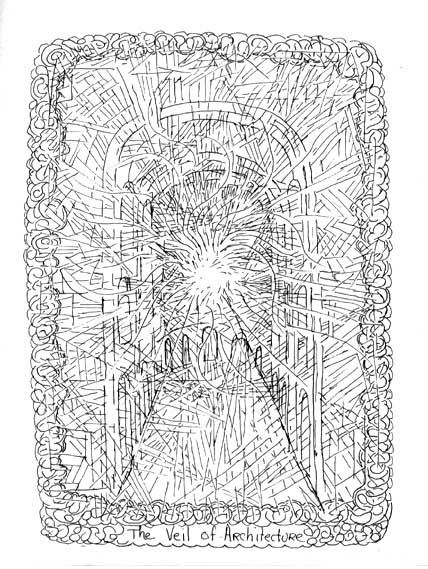
The Veil of Architecture
|
wanted to punish Byzantine artists who minimized spiritual revelation in
religious art rather than emphasize naturalistic representation. A similar
hatred of images can be found in Islam and in Puritanism, and in all these
cases, the hatred of images is based on a fiction of the superiority of an
imaginary imageless deity.
My veil symbolism was partly an
effort to justify images. The basic idea was that the creator shines through the
creation and therefore the created is also of importance. This is basically the
standard theory found in many religions. I had not yet realized that the whole
spiritual edifice of "Creator/Created" and unveiled/veiled was nonsense, mere
flimsy metaphor gone wild and turned into dogma and principle. I was taking such
symbolism as the creator/created or the veiled/unveiled out of their contexts
and interlacing them in my drawings---combining them together in syncretistic
and perhaps somewhat Orientalist works. The transcendent symbolisms used in
Christian cathedrals, Tibetan Buddhist Thankas, Hindu temples or other religions combined readily with the romanticism of
Shelley, Rilke, Rimbaud or Mallarme. The result is a personal view of the world
which attempts to come to a synthesis between the personal and the universal,
modern and the traditional, the old and the new, science and religion.
I wanted to somehow escape the repressiveness of those who hate art and see it
as something evil and idolatrous, on the one hand, and those who manufacture
explotive images endlessly, spiting out advertisements and propaganda 24 hours a
day seven days a week. I wanted, in other words, to have an art that does not
serve powers. Does
it succeed in this?
No, it tries to, but it could never really succeed,
because I did not yet have a deep enough understanding of how cultures operate. I didn't
yet realize that my veil imagery was itself a veil that hid me form the more
profound truth that there was no veil---there is only this world, this being,
this existence and nothing beyond that. My
understanding of other cultures, such as Islam or Tibetan culture was not mature
enough to understand how such systems operated in their social context. I did
not yet understand how aesthetic symbolisms help orchestrate social powers. I
would come to understand this in later years and then I rejected the use of
spiritual symbolisms in art entirely. But the drawings have not yet achieved
this understanding. They are youthful explorations into subjects that were then
just opening up for me. The best I could say is the drawings point a way toward
an understanding of the dilemma about knowledge and power that I could only
dimly imagine in 1982. It implies the breakdown of religion as
having
any other value but as a system of psychological props. My drawings imply that
religion has no 'truth value'. But this was implicit in the drawings and I did
not yet understand this explicitly.
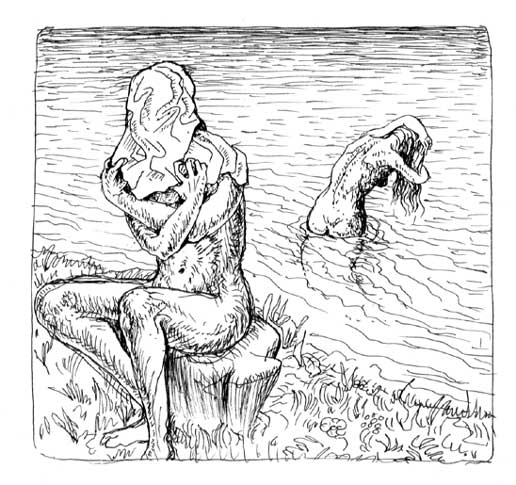
The Final Veil Drawings
I came to understand only very slowly that
the influence of religions is over all a negative force in my life and that
abandoning religion was for the good. Leaving religion was an amazing experience
in many ways. Many people with whom I had relationship based partly on a common
interest in religion no longer saw me as the same person. Some people were hurt
by my change, and some even came to hate me, or vilified me for changing. Some
people issued death threats and hurled threats of my damnation.
Religion is a system of mind control and a form of addiction, and those who were
very addicted to religion saw me as an apostate to their particular form of
opiate. Christianity and Islam both have elaborate systems of implied
punishments for those who refuse to take the ideological drug of their teachings
anymore. Islam actually proscribes death for those who leave Islam, and
Christians readily damn non-Christians to hell. But as I see it, I have the
perfect right to join or leave any religion freely without punishment. I went
into religion and tried it on to see if it fit me. It did not. So I left it
behind as a system that involved me directly. I still find the phenomena
interesting, but only as an outsider, not an insider.
The veil drawings continue for some years,
but the effective end of the style is already in sight when the drawings
increasingly reveal a dark and tragic tone, that, unknown to me at the time,
grew out of the subject matter itself. The metaphysic I had superimposed on the
style ultimately strangled what was good in the style. In the most complex of
the drawings I began to struggle with
the inhumanity of transcendental and religious symbolism.. This may have been
appropriate, given that one of my main purposes in these drawing was to express
something about the self destructive nature of the time we live in. These
drawings ultimately point the way to the painful abandonment of religion as
having anything other than a literary or historical value. The Philosophical
Drawings are a kind of elegy for religion, which may explain their rather
odd medieval style, evoking both the Book of Kells, the Animal Style of ancient
art and and Hindu temples. This orientalist medievalism is often
contradicted by the modern content of the subject matter. In the end the
style negates itself, since I could not ultimately endorse either modernism or
traditional thought. In the end what matters to me was not systems of knowing but
actual existence, animals, birds, the people close to me that I love, the
flowers I myself planted. In the end I gave up the tragic view of life implied
both by modern physics and traditional religions.
What might be called the last of the most complex of the veil drawings was never finished. It became complicated beyond
my means or desire to finish it. All I have of it is the conception, expressed
in numerous sketches of what the final thing might have looked like. The drawing
centered around a notion of history as a "mill wheel of thought". There were
various drawings of the mill wheel of history, some of the sketches for this are
below
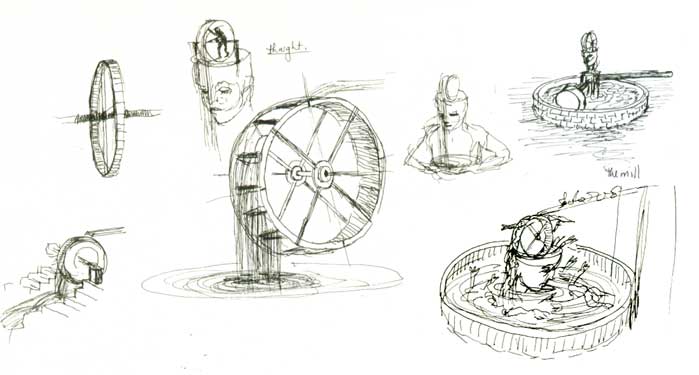
The mill wheel is an image of cruelty, rather Kafkaesque and surreal. The idea was
that history is a veil being woven by a woman weaving vegetable, human and animal forms out of her body into a thread and the thread
is then spun on a spinning wheel and then the thread turning into a spool of
thought, a mill wheel in a man's brain mounted on top of a mill wheel which
grinds or perhaps dyes the spun substance into some sort of thread that is woven by the woman in the
background into a veil. But the dye or substance which colors the veil is the
dead bodies of many people.
Below I have reconstructed something
of the original idea of
the composition. The finished drawing would not have looked like this, probably.
But it gives and idea of the whole concept. The woman and her spinning wheel
spinning life forms into threads appears on the right. The The Mill wheel is
making the thread into colors and the woman in the background weaves the thread
into the veil. The Veil appears as both a
mysterious and entangling curtain. In the middle drawing a skeleton hanging in the threads,
an image that gives the veil a deathlike or tragic character. Admittedly there
was a presence of death which I assumed to be part of the Vision of the Veil
from the beginning, but here the
reality verges on the grotesque. The man seeks to 'penetrate' the veil and in
the process some die of the attempt, rather as in the myth of the Sphinx
where the Sphinx killed men who could not answer her riddle. In 3rd section of
the drawing, to the left, a man caught or entangled , or perhaps escaping from an
entangling veil, almost as if he is caught in it in
as in a spider web. Another man, an image of the suffering and bleeding martyr
for truth. All these images would have been combined somehow in the final drawing. the net result would
have been a very pessimistic drawing of the
veil making of history as a kind of "Deus ex machina" a fatalistic
notion of
existence as an arena of cruelty created by the gods for their sport.

The idea of history that results is
repulsive and mysogynistic. There are many writings dealing with the
Veil in general through out this period of my work. The drawing for this work
are spread over a fairly long period, roughly from 1981 to 83.
But I do remember being very frustrated with it and attempting to work on it and
giving up a number of times. I think I now understand the reason I could not
finish it.
Why is this drawing repulsive tome
now? To answer this I have to explain a few things. There is only one specific
written mention of
this particular drawing in my notebooks. It states "at her winding wheel she weaves our bodies into
the many shapes of sorrow. (All the animals of Noah turn in her wheel)" This is
rather a pregnant sentence and says to me that I was creating a kind of
fatalistic vision of life and history that implied a brutal mechanistic history
run by autocratic gods who "kill us for ther sport" as Shakespeare put it. Such
a view of life might sit well with some people. The Hindu idea of Karma, for
instance, essentially is this: that your fate is determined by the gods or the
mechanism of divine accounting and that only by Herculean efforts and endless
labor over mellinnia and eons can one gain the "human estate" and even
when it is gained, it can be taken away for one moral indiscretion. The
notion of Karma is human-centered demeaning to animals and nature, since animals
and nature re lesser on the scale of values that are humans. The Hindu/Buddhist
notion of Karma is essentially a kind of moral blackmail by society exercised over
those who believe in the system of religion and its rules. It justifies the
caste system and the hierarchy of priests and upper class exploitation of the
poor. the Christian notion of original sin, hell and punishment serves the same
social purpose. The drawing above combines Hindu, Buddhist, Greek and Christian
ideas. The drawing illustrates to me how repulsive these ideologies really are.
Bt recognizing that this drawing was implicitly objectionable I was seeing that
the traditionalist ideea of the Veil, such as that expressed in Sufi writing of
Rumi, or in Jewish architecture in the "Veil of the temple"-- that such ideas
are intrinsically cruel and ethically objectionable.
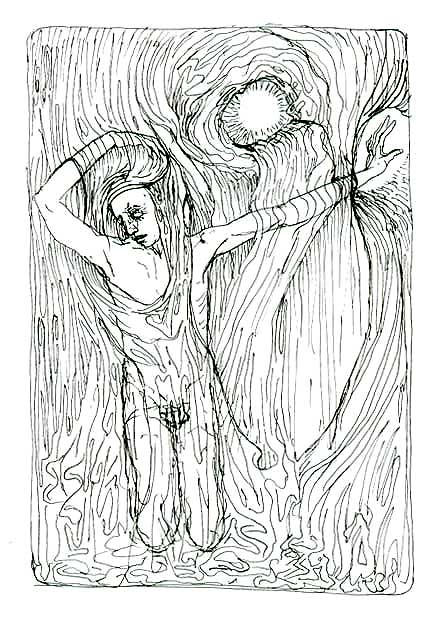 |
There is implicit in the drawing a notion derived from Greek theatre, in plays
such as those written by
Aeschylus and Sophocles.
The gods are behind the veil. Humans are helpless puppets caught in he web that
the gods made. Both the Greek fatalism expressed in Greek theatre and Buddhist thought, with its
notion of Karma or the "round of existence" assume a fatalistic vision
of society as an endless source of cruelty. I find this sort of vision, with its implicit teaching of submission of
resignation to the will of the gods or the wheel of karma as a affront to nature
and
existence and respect for the rights of beings. I dislike and renounce this sort
of fatalistic and totalitarian belief system.
The notion that an individual, such as the Buddha, or Christ, has
escaped or overcome "the world" or existence into some supernatural realm beyond
the world is absurd. The veil is not something that liberates, but something
that has no exit and which entangles. I show is is this later drawing of the
veil, probably form 1983. It shows a man hopelessly entangled in the veil
and though he reaches for release, it seems unlikely to be coming.
|
The world is not something to be overcome: it is all that there is.
No one has ever 'gone beyond the world'. There is no Veil that separates
this world from that. This is a mythological dream. The world is not something to be
denigrated by an intellectual notion of
supreme human consciousness arrogating itself ultimate meaning and authority.
There is no other world, no "OZ" and the wizard of Oz is a snake oil seller.
And "there is no place like home".
The last few Veil drawings are exploring a view of the world
I could not accept, even 20 years ago, and I think this is why I
could not finish it. The Veil ideal ended in a cul-de sac of endorsement of
religious values, social cruelty and implicit pessimism.
When I began constructing the Veil imagery in the Philosophical Drawings I
certainly had no idea that it would end in a implicit acceptance of
hierarchy and
systems of monarchist and transcendental mind control. I did not realize this, certainly in 1982.
All I knew then was that I could not finish the drawing and I did not know why.
It would take me another 8 years to figure out why. I remember looking at these
drawing in he early 1990's and being horrified about what I had let myself
express. That is how it was in the early 1980's. My art lead me more than my
mind did. My art was more trustworthy than my intellectual capacities. I did not
yet have the mental or intellectual means to grasp what was wrong with these final veil
drawings. I only knew that something was wrong, but could not say what. 20 years
later I can explain what was wrong.
I could not continue with the drawing and
abandoned it because I could not get myself to accept the meaning implicit in
it. I could see dimly where it was going. At the same time I don't think I was yet able
to question these meanings that I now see in it. I simply did not have the
maturity of the knowledge to assess such a complex and far reaching image. So I put the drawing on hold,
telling myself I would finish it someday, but never actually getting around to
doing it.
There was an earlier vision, recorded in a earlier notebook form
1979, which pictures a similarly deterministic and pessimistic. The drawing
is accompanied by a text which states that this explains the sculpture. It
would be inside a room, and that the room would have door made of quartz
crystals and children's faces embedded in it. Inside the room are bell jars
on pedestals and each bell jar contains an hanging wire puppet. One is Van
Gogh, another Da Vinci, another Shakespeare and Homer, etc, on back into
history. Silver strings glisten in the blackness that leads into the
infinite ceiling above. This is an early version of the vision of the veil
and veil drawing above. I dislike the idea implicit in it very much. It is a
restatement of Greek fatalism, or of mmonotheistic totalitarianism. It
expresses a hopeless sense that life and genius are determined by
gods of unseen forces. I do not believe now and don't believe I did believe
20 years ago
that Van Gogh was a puppet of the gods, the state or any other over arching
fabulation. He was a free man struggling to express what he loved on earth,
but who suffered from poverty and stress and some kind of mental disability.
I now think that an idea in the drawing to
the right has some haunting qualities-- the children's faces in doorway, for
instance. But it is pessimistic nonsense. A Kafkaesque vision of culture as
a macabre joke of imaginary gods.
|
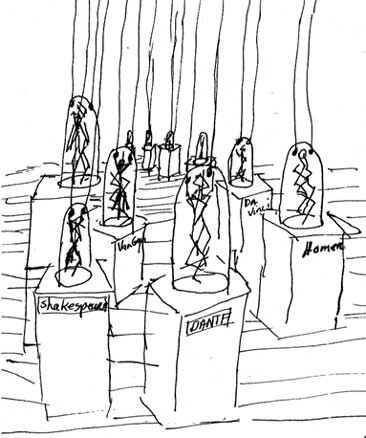 |
The important question is where did I
get such notions and why did they come forth from me in such unforeseen and
visionary ways? My parents forced us to attend Catholic Church. I think I also
derived some of my interest in religion form the search for alternative to
westerns culture that went along with rebellion in the 1960's. I
think such ideas were instilled in me subtly by school, churches, TV, my
peers, my culture. Moreover, these drawings are openings to a almost satirical
view of the very things that they might seem to be advocating. The veil imagery
contains its own dissolution, its own unraveling.
So then, what was my mistake? I did not see that the veil imagery implied
social inequalities and cruel philosophies. There is a hint of misogyny in some
of these drawings, with the typical medieval Christian or Hindu Buddhist notion
of woman as entangling force, and man as a being who seeks escape from the
entanglements of life by seeking "beyond the veil of existence" into a hidden
realm of spirit beyond. This sexist ideology, which can also be found in
Symbolist art and literature, took me some years to begin to question in
myself. My vision of the veil had led me deeply into these beliefs, even to the
point where I studied carpet weaving and learned how to support myself repairing
and restoring Oriental carpets. I made a living repairing and restoring oriental
carpets for 6 or 7 years. I became a Sufi for a time, partly because of my
interest in weaving, veils, and sewing. The ideology of the
veil as a spiritual idea grew on me, and I learned to separate the world into
false dualism and even more false notions of divine unity. I did not yet
understand that traditional symbolism held some very destructive ideological
components. Veil symbolism is still used to this day to discriminate against
women, deny them rights, and force them into lesser and subservient
status. This is the case in Islam, where veils (hijab) are forced on women as part of a
panoply of discriminating, unjust treatments. I have seen the symbolism of nudity used for similar purposes. But I had no understanding that traditional religions are
essentially misogynistic in 1982, though I had inklings. I had no way to follow
my inklings at that
point for the simple reason that I did not know enough and was unable as yet to
situate and understand all the factors involved.
Of course, one could protest that the notion of
implicit in the drawings of woman as
creator of the Veil empowers women as the creative force of nature, as Kali is
seen as a creative/destructive force in Hinduism. But this
protest does not negate the fact that in traditional mythologies, the feminine
creative force of nature is almost always denigrated as inferior to the
masculine force of transcendent knowledge or "Being", which is usually set in
opposition to an inferior "becoming". Becoming is the veil, Being is
the force that creates the veil. Nirvana precedes and defines samsara. The
notion that "Atma
creates maya." is metaphysical nonsense. What is called "maya" or the
"veil" is a created fantasy. What is real is the actuality of the world, which
is all the poetry one needs. If only the veil is real there is no veil. What is real is ones actual self, not the fiction
of "atma" or Aurelius' "daimon", Eckhart's "intellect", Plotinus' and his
imaginary "nous", Heidegger's "Being" and other self aggrandizing fictions of this kind. Metaphysical
notions of the "Self" are misogynistic denigrations of women and earth.
In the early 1980's I had not yet learned to question this sort
the misogyny inherent in traditional religious values. Nor had I came to any
understanding that the metaphysical ideas of the major religions not only
advocate an implicit and unrecognized hatred or prejudice against women, but
that also they tend to advocate for male centered values and sometimes an implicit if unadmited homosexuality.
I have nothing against homosexuality. But I deplore the hypocrisy of some
aspects of Christianity, where homosexual priests are very
common, this being a natural result of the Christian despising of sex, women and
the ideology of "original sin". But one can find the same tendency in Hinduism for instance with
Ramakrishna's homosexual tendencies, demonstrated by Jeff Kripal. But even more
than this, the traditional religions tend to be highly prejudiced about animals.
It would be some years before I became aware of these tendencies
in traditional religious values. It was partly awareness of the homophobic, misogynous and elitist tendencies of
the values of most of the major religions that decidied me to abandon myth making and myth
creation. I realized that i was deeply involved in creating and sustaining
mythology and that i had examined some basic false or harmful assumptions
assumed to be true int he major religions. Myth creation is a major function of
poetry and art. Becoming aware of my responsibility as an artist and poet,
meant that I had to abandon such myths as I was creating and sustaining in such
drawings as the last drawing about the veil.
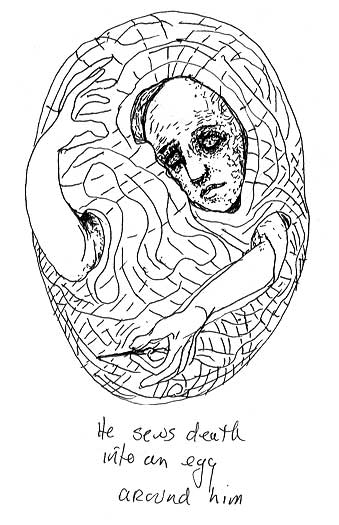 |
I admit that of all the mythologies that my art and writing lead me into,
the veil symbolism was the one that I worked hardest to create and which
most deeply engaged my heart and mind. i was deeply in love with the idea of the
veil and it was a hard myth to give up. Even now some of its beauty and magic
still haunt me. It was very difficult to abandon this idea. But I did abandon
it. I suppose that it could be said that it was partly the attempt to develop a
metaphysical notion of the Veil, and all the drawings that resulted from this
attempt, which led me eventually to abandon myth and religion. In this sense, I
should be grateful to these drawings, since they laid out for me some of the
injustices of religious ideology. I might not have seen these injustices as
clearly had I not done the drawings.
But there is no doubt that to some degree the vision of the
veil was a vision of death and I wove the symbolism of the veil around me as
a kind of death web. Like symbolism in all the major religions, the veil
symbols was an escapist fantasy. Like this drawing, perhaps, the veil symbol
that I tried to sew myself into eventually became an egg that birthed me out
of religion all together. I am grateful to the veil for that. |

One of the last deliberately planned, complex drawings I did was the The Fall:
Tragic Veil. This drawing is very complex and probably is more of
less incomprehensible without an explanation. But I will explain it in
the chapter on language rather than here. I will only say of it here that it
expresses a rather pejorative notion of the world which is due to the
symbolism of the veil and its prejudice that the world hides a hidden
reality behind the 'veil of appearances". I remember thinking when I did
this drawing that something was finished. I should have known that this was
the end of the Philosophical Drawings or one of the the last of my metaphysical
artworks. What this drawing suggests, wrongly, is that that reason and science have
failed. This is represented by the man falling with Greek columns broken and
books the late equations of Einstein pointing towards dissolution and nuclear
annihilation. Everything is collapsing into he sea of arcane and archaic
languages, Hebrew, Egyptian, Sanskrit and others. In other words, religion is
here defined as the irrational, the undifferentiated. The failure of science
consigns mankind to a sea of death, that is the sea of religion. After this drawing the style declines toward its eventual
exhaustion in 1991. Of course it would take quite a few years for me to work
myself out of the beliefs that went into the creation of these drawings. But the
veil symbolism did not develop any further than this. When I did this drawing I
did not know it was the dead end that it was. But it would have saved me alot of
time had I seen that religion ultimately fails us. It consigns us to ignorance
and a sea of superstition.
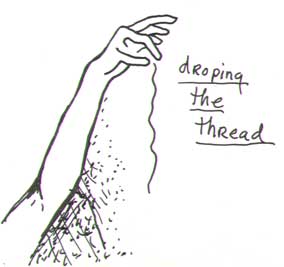 |
I realized at last that the veil symbolism was based on many falsehoods.
Without losing my love of actual
veiling in nature, such as one sees in sunlight coming through spider webs, autumn leaves
or morning light thorough a woman's hair. But I gave up the Veil at last. I gave
up the idea of the Veil as a metaphysical symbol. Or rather, I gave up the
belief that there was any world behind any notion of any mythical veil. The
idea of a world beyond this world or beyond death is false.
Some of the Philosophical Drawings were perhaps meant to be "spiritual" drawings, but
at the basis of this "spirituality" is a person, myself, and the drawings were
being done to serve a need I had. That need proved to be temporary. It was in
need of protecting myself from harmful aspects of out world. The physical and imaginative
fecundity of these drawings still enchants and surprises me. That is what has
lasted in them. I am aware
that these drawings, like a religion whose members have all passed away, are
mythological relics of a time when I could still believe in a creator who lived
in beauty behind a shimmering veil of delicate light, shinning down on me
and from within me with radiant beneficence, illuminating the kaleidoscopic
realm of Maya. I don't believe in this anymore. But the period has a certain
enchantment, like the art of a culture that no longer survives. |
So In conclusion, what do I
learn form my experience?. I learn from my record of experiences in these
drawings that the steps along my path as reflected in these drawings was honest
enough that I can look back at my "vision" and follow out its implications.
Years later I have been able to trace back my vision to its sources, and see
that it was not a "revelation" at all. It was an intuitive awareness of the
wonder of the world. For various reasons have to do with loneliness
or need of security I inflated this intuition into a full blown visionary and
metaphysical doctrine. I believe
that what I did with the vision of the veil is exactly what the religions do
with their basic mythical original stories. Christ was not resurrected, but the
myth that he was developed in the mists of early Christian history, were
inflated, and become part of a doctrine that justified a huge institutional
apparatus. Buddha did not defeat death and desire under the Bodhi tree. But the
myth that he did was inflated into and magnified into a huge intuitional
apparatus, which itself become the justification for the mythic sleight of hand.
I don't believe in anything spiritual
hiding behind the world anymore. The wonder of the world is its own. The
existentialists and the religious are wrong to believe that the world without
god is meaningless or empty. It is a marvelous world and we need not gods to
support its wonders. The beyond is nowhere. The beyond is merely the notion of
consciousness turned back on itself in meditation. It is a mirror that stops
thought and illuminates being. But that illumination doesn't really explain
anything. The intellectual abstraction of 'being' that is at the core of the
major religions has definite and negative consequences on the natural world.
God, Tao, Atman, Brahman., Christ, Intellect, Heidegger's notion of Dasein or
the Buddhist or Hindu notion of the Void are abstract
non-entities which set man against nature. All the traditional religions assume
that the mind or being in contemplation of itself is superior to nature. Thus all the religions, in
their basic metaphysical constructions are anthropocentric and contain values
harmful to the natural world. Even the religion that is supposed to be most
friendly to nature, Buddhism, defines nature as as of lesser value than
humanity. The whole notion that "desire is suffering" and that the Buddha
transcended suffering condemns nature to the realm of inferiority.
Moreover, the notion that human birth is better than all other births, which is
the key idea behind Karma, denigrates nature and animals. I gave up religion as a
meaningful description of the world. I gave up the idea of a veil separating this
world from that. There is only this world, no other.
I created not only a style of drawing
but a metaphysical and aesthetic theory to go along with it. I realized that my theory, while beautiful, interesting
and very flexible in its ability to describe and symbolize, was nevertheless
false, mistaken, simply not true. Thus I learned that my own mind is
alternately amazingly fertile, uncertain, changeable and groping for
understanding but that for all the wonder that it is capable of it is also
capable of delusion, entertaining falsity, clutching to false hopes and dreams
in spite of contrary evidence. I learned that a truly complete "objective"
factual understanding probably does not exist. But on the other hand, there is a
reality in the world and how one views the world does affect what happens in
one's life. One must try to be accurate: tell the truth as best one can. The human mind creates coherence,
and needs to make mythic structures, just as the human mind also needs to
question such structures and is unable to adhere to the dictates of what it
creates. Life is more important than ideas. Ideas are not reality. Ideology is
not reality. Life is reality. Life is hard and wonderful, painful and full of
beauty. Reality is not a system but; irreconcilable changes.
If these drawing have a weakness, it is that some of them are not
uncertain enough. I was struggling to create certainty in them, and it is
paradoxically this that makes some of them heavy handed or dogmatic, mere
assertions of superstition and beautiful lies that I clutched to. Indeed, what
my creation of the theory of the Veil taught me was that I myself could create
a religion. Anybody can make one if there is enough longing and homesickness.
Once I created the Veil theory I was in a position to begin to understand how
whole societies had created elaborate systems of beautiful lies to comfort the
longings and fears of centuries of people.
Religions are
created edifices of dreams and hopes. They are chimeras built up and magnified
into huge, timeless and "eternal" proportions. Make no mistake, there is beauty in the creation
of the religions. There is beauty in the faith that some people put into these
chimerical hopes and dreams. But the constructions are false, and easily come
tumbling down, dissolving like mirages or spider webs, melting into nothing,
causing pain and heart ache to those who are duped and taken in by lovely lies
and artful deceptions. Wagnerian operas and Eucharistic communions, Immaculate
Conceptions, Buddha's Enlightenment are titanic fictions. But once one finds out
the Virgin did not get pregnant through the ear, and Christ's body is empty
magic, Muhammad did not get the Koran form Allah, and the Bible is not the
inspired word of god, the game is up and the curtain pulled back and religion is
revealed as merely another theatre of masks and fake gods.
It was not
the intellectual edifice that I created around these drawing that mattered, but
the fact of my seeking to grasp the meaning of the world and so often failing.
The failure was more important than the arrival at certainty. The Philosophical Drawings is a book of failed dreams, but also a book
of successful loves and
intimate hopes. The best of them ask questions and pose conflicts and express
feelings without necessarily solving the conflicts. All of them indicate a
drive and an endless appetite to love life and express creative energy. The
worst of them point toward a polemics of programmatic iconography. It is always
a mistake to fail to deconstruct not quite
digested symbols. Here is have deconstructed the symbolism of the veil and shown
it to be a basic symbol in the ideology of the religions. My drawings helped me
to see this. Thus, some of the drawings are part of a story or indicate meanings
that are interesting even if, as art, they are not my best work. On the
other hand some of these drawings are good as drawings, as art. It brings
me a certain joy to revisit some of the intricate meanings. I loved doing these
drawings and still love something about them, with all those years gone.
******


Copyright © 2004-06 Mark Koslow.
All Rights Reserved.
|